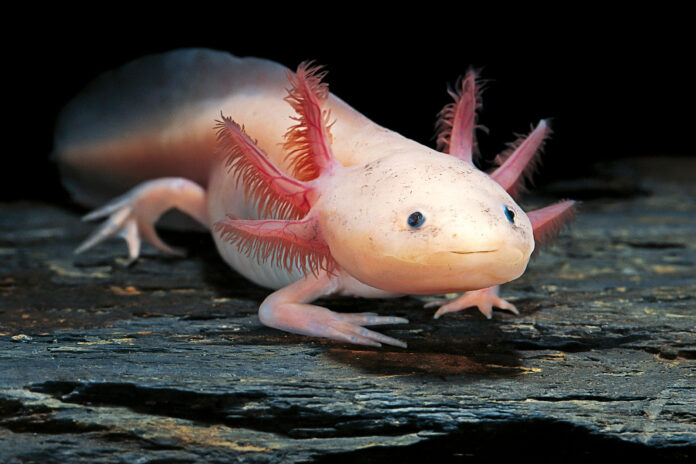Have you ever heard of an axolotl pet? No, it’s not a mythical creature from a Harry Potter novel, although it might as well be with its whimsical appearance. These adorable and quirky creatures are real and becoming quite popular as pets. But before you jump on the bandwagon, let’s take a closer look at what an axolotl is, its characteristics, and whether or not it makes a good pet.
What is an Axolotl? Facts and Introduction to Axolotl
The axolotl, also known as the Mexican walking fish, is a salamander native to Mexico. Unlike other salamanders, axolotls do not undergo metamorphosis from their larval stage, meaning they retain their gills and remain aquatic their entire lives. Axolotls are known for their incredible regenerative abilities – they can regrow limbs, spinal cords, and even parts of their brains!
Axolotl pet Characteristics
Axolotls have a unique appearance that sets them apart from other pets. They have long, slender bodies and four tiny legs, which they use to walk along the bottom of their tanks. They also have feathery gills on the sides of their heads that they use to breathe underwater. Axolotls come in various colours, from pale pink to dark brown, and they can even change colour depending on their environment and mood.
One fascinating thing about axolotls is their regenerative abilities. They can regrow lost limbs, spinal cords, and even parts of their brains! This makes them a subject of interest in scientific research, as they could potentially hold the key to regenerative medicine for humans.
Axolotls are also unique in that they are neotenic, which means they retain their juvenile features into adulthood. Unlike most amphibians that undergo metamorphosis, axolotls remain aquatic and keep their gills, which allows them to breathe underwater. This also means they have a completely different set of care requirements than other amphibians.
Axolotls are native to Mexico, where they are considered a delicacy and are at risk of extinction in the wild due to habitat destruction and pollution. They are also popular in the pet trade, which has led to over-harvesting and a decline in wild populations.
Axolotl Colours that are commonly found:
Axolotl colors vary widely, making them popular and visually striking pets. There are several different colours and colour patterns that axolotls can display, which can be influenced by genetics, environment, and age.
One of the most common axolotl colors is wild-type, a dark grey or brown colour with speckles. This is the natural colour of axolotls in the wild, and many pet axolotls still display this colouration. However, there are also several other Axolotl colors that are commonly seen in pet axolotls, including albino, gold, and copper.
Albino axolotls lack pigment and have pink or white skin and red eyes. Gold and copper axolotls are characterized by their metallic, shimmering colours, with gold axolotls having a yellow-gold hue and copper axolotls having a reddish-brown colour.
There are also several other colours and colour patterns that axolotls can display, including melanoid (black), axanthic (gray), and piebald (white with black spots). Axolotls can also change colour depending on their mood or environment, with some axolotls becoming lighter or darker in response to stress or changes in temperature.
The Pros and Cons of owning an Axolotl as a Pet
Like any pet, there are pros and cons to owning an axolotl. Here are some things to consider before taking the plunge.
Reasons to Get an Axolotl Pet (Pros):
- They’re low-maintenance pets. Axolotls don’t require daily walks or trips to the park – they’re perfectly content spending their entire lives in their tanks.
- They’re fascinating to watch. Axolotls have unique behaviours, such as their ability to regenerate limbs and constantly explore their tanks.
- They’re peaceful creatures. Axolotls are not aggressive and can be kept with other fish or axolotls without issue.
Reasons to Consider Before Getting an Axolotl Pet (Cons):
- They require a specific environment. Axolotls need a tank with the right temperature, water quality, and substrate to thrive. This can be a bit daunting for first-time pet owners.
- They’re not cuddly pets. Unlike dogs or cats, axolotls are not pets you can pick up and snuggle with. They’re best enjoyed from a distance.
- They can be expensive to care for. While axolotls themselves are not expensive, the equipment and supplies needed to care for them can add up quickly.
Axolotl Living – What are the basic requirements?
If you’ve decided that an axolotl is the right pet for you, here’s what you’ll need to create a suitable living environment for them.
- Appropriate tank Size: Axolotls need a tank that is at least 20 gallons, although more significant is always better. A long, shallow tank is best, as axolotls are bottom-dwellers and don’t need much swimming space.
- The water temperature: Axolotls prefer water temperatures between 60-68 degrees Fahrenheit. It’s essential to invest in a good-quality aquarium heater to maintain a stable temperature.
- Toxicity of the water: Axolotls are sensitive to changes in water quality, so it’s essential to monitor the levels of ammonia, nitrite, and nitrate in the water using a water test kit. A water change of 25% should be done weekly to keep the water clean.
- Light inside the tank: Axolotls don’t need a lot of light, but it’s essential to provide a consistent light cycle to help regulate their internal clock. A timer can turn the lights on and off at set times.
- Substrates: Axolotls prefer a soft substrate, such as sand or fine gravel, as they like to bury themselves. Sharp or rough substrates can damage their sensitive skin.
- Plants and hideouts: Axolotls need places to hide and feel safe. Live or silk plants can provide cover, and a hideout or cave can give them a place to retreat.
Average Cost to Own an Axolotl as a Pet
Now that you know what’s required to care for an axolotl, let’s look at the average cost of supplies and equipment needed to keep them healthy and happy.
- 20-gallon aquarium tank – $50-$100
- Filters – $20-$50
- Plants – $10-$30
- Hideout – $5-$20
- Thermometer – $5-$10
- Water test kit – $20-$30
- Axolotl food – $10-$20/month
- Other not compulsory but “good to have” items – $50-$100 (such as an aquarium heater, lighting, and decorations)
Axolotls don’t require expensive food or veterinary care, making them affordable pet in the long run.
Axolotl Rating as Pets
Now, the million-dollar question – how does the axolotl rate as a pet? Let’s break it down.
Cost: 0.5/1 – While the initial investment in equipment can be expensive, the ongoing cost of upkeep is relatively low.
Maintenance: 0.5/1 – Axolotls require a specific environment and regular water changes, which can be time-consuming. However, they don’t require daily attention or exercise like other pets.
Handling: 1/1 – While axolotls aren’t cuddly pets, they can be fascinating to watch and interact with. They’re also peaceful creatures that can be handled with care.
Wrapping Up
Overall, axolotls make great pets for those looking for a low-maintenance, unique, and fascinating animal companion. The wide range of axolotl colors makes them an exciting and unique pet, and many owners enjoy collecting different colour variations. With the proper care and environment, they can live in captivity for up to 15 years, providing their owners with years of enjoyment and wonder.
The axolotl may not be the first pet that comes to mind when considering a new addition to your family, but it’s worth considering. With its unique appearance and fascinating behaviour, the axolotl will surely capture the hearts of anyone who gets to know it. However, before deciding to bring an axolotl home, it’s essential to consider the pros, cons, and specific requirements to provide a suitable environment for these amazing creatures.
Frequently Asked Questions (FAQs):
What do axolotls eat?
Axolotls are carnivores whose diet consists mainly of live or frozen food such as bloodworms, brine shrimp, and small pieces of meat. They can also eat pellets or flakes designed for aquatic carnivores.
Do axolotls need a filter in their tank?
Yes, axolotls need a filter in their tank to maintain water quality and prevent the buildup of harmful substances like ammonia and nitrite. A good filter should have a low flow rate and be gentle enough not to stress the axolotl.
Can axolotls be kept with other fish?
Axolotls should not be kept with other fish as they are carnivorous and may try to eat them. Other fish may nip at the axolotl’s gills or fins, causing injury or stress.
How often should I clean my axolotl’s tank?
Axolotl tanks should be cleaned once a week to maintain water quality and prevent the buildup of waste and harmful substances. During cleaning, partial water changes should be performed, and any uneaten food or debris should be removed from the tank.
Can axolotls live out of water?
Axolotls are fully aquatic and should not be kept out of water for extended periods. However, they can survive short periods out of the water if their skin remains moist and they are not exposed to direct sunlight.

















